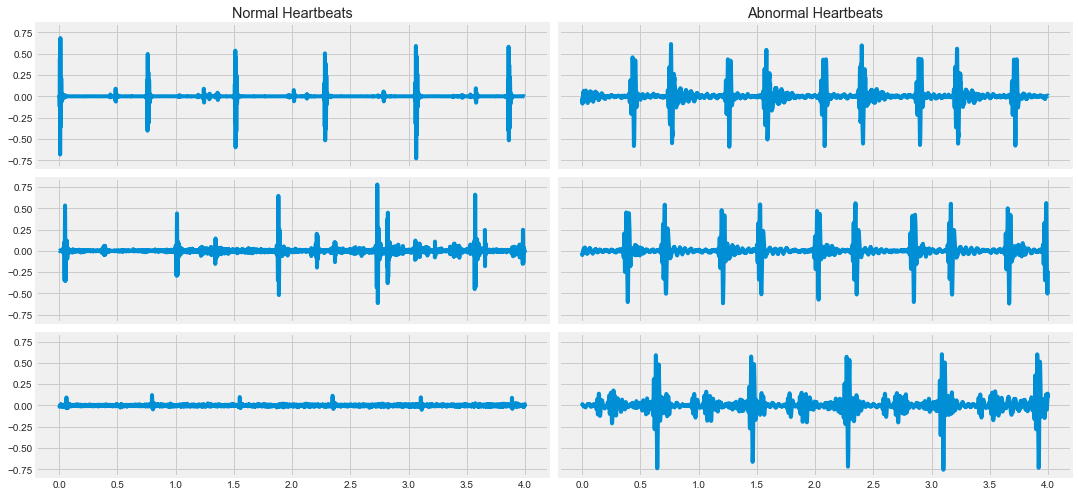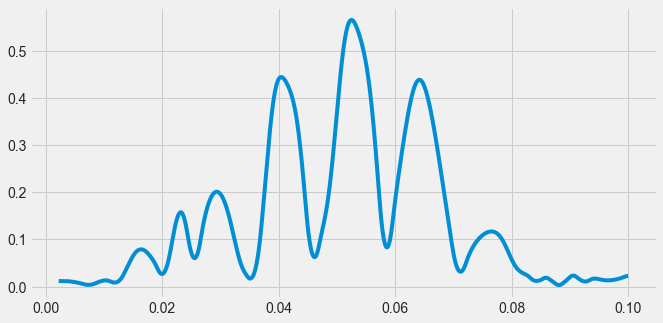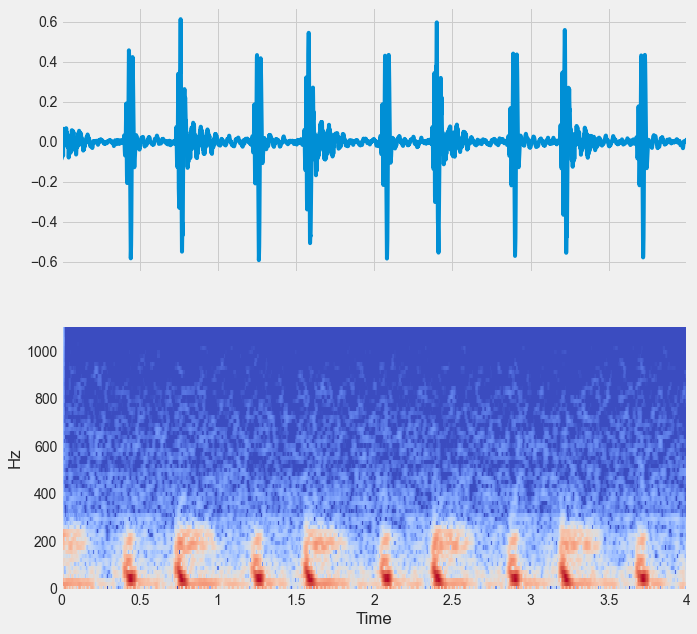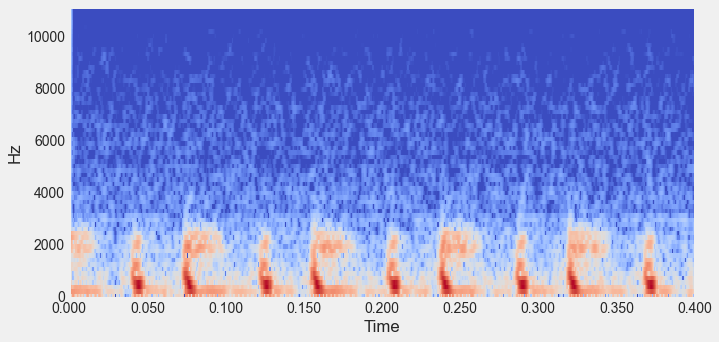Code
import pandas as pd
import numpy as np
import matplotlib.pyplot as plt
import seaborn as sns
import librosa as lr
plt.rcParams['figure.figsize'] = (10, 5)
plt.style.use('fivethirtyeight')kakamana
January 24, 2023
To include time series in your machine learning pipeline, you use them as features in your model. We will briefly covers the common features that are extracted from time series for machine learning.
This Time Series as Inputs to a Model is part of Datacamp course: Machine Learning for Time Series Data in Python
This is my learning experience of data science through DataCamp
In this exercise, you’ll start with perhaps the simplest classification technique: averaging across dimensions of a dataset and visually inspecting the result.
You’ll use the heartbeat data described in the last chapter. Some recordings are normal heartbeat activity, while others are abnormal activity. Let’s see if you can spot the difference.
Two DataFrames, normal and abnormal, each with the shape of (n_times_points, n_audio_files) containing the audio for several heartbeats are available in your workspace.
fig, axs = plt.subplots(3, 2, figsize=(15, 7), sharex=True, sharey=True)
# Calculate the time array
time = np.arange(len(normal)) / sfreq
# Stack the normal/abnormal audio so you can loop and plot
stacked_audio = np.hstack([normal, abnormal]).T
# Loop through each audio file / ax object and plot
# .T.ravel() transposes the array, then unravels it into a 1-D vector for looping
for iaudio, ax in zip(stacked_audio, axs.T.ravel()):
ax.plot(time, iaudio)
show_plot_and_make_titles()
print("\nAs you can see there is a lot of variability in the raw data, let's see if you can average out some of that noise to notice a difference.")
As you can see there is a lot of variability in the raw data, let's see if you can average out some of that noise to notice a difference.
While you should always start by visualizing your raw data, this is often uninformative when it comes to discriminating between two classes of data points. Data is usually noisy or exhibits complex patterns that aren’t discoverable by the naked eye.
Another common technique to find simple differences between two sets of data is to average across multiple instances of the same class. This may remove noise and reveal underlying patterns (or, it may not).
In this exercise, you’ll average across many instances of each class of heartbeat sound.
# Average across the audio files of each DataFrame
mean_normal = np.mean(normal, axis=1)
mean_abnormal = np.mean(abnormal, axis=1)
# Plot each average over time
fig, (ax1, ax2) = plt.subplots(1, 2, figsize=(10, 3), sharey=True)
ax1.plot(time, mean_normal);
ax1.set(title='Normal Data');
ax2.plot(time, mean_abnormal);
ax2.set(title='Abnormal Data');
While eye-balling differences is a useful way to gain an intuition for the data, let’s see if you can operationalize things with a model. In this exercise, you will use each repetition as a datapoint, and each moment in time as a feature to fit a classifier that attempts to predict abnormal vs. normal heartbeats using only the raw data.
normal_train_idx = np.random.choice(normal.shape[1], size=22, replace=False).tolist()
normal_test_idx = list(set(np.arange(normal.shape[1]).tolist()) - set(normal_train_idx))
abnormal_train_idx = np.random.choice(abnormal.shape[1], size=20, replace=False).tolist()
abnormal_test_idx = list(set(np.arange(abnormal.shape[1]).tolist()) - set(abnormal_train_idx))
X_train = pd.concat([normal.iloc[:, normal_train_idx],
abnormal.iloc[:, abnormal_train_idx]], axis=1).to_numpy().T
X_test = pd.concat([normal.iloc[:, normal_test_idx],
abnormal.iloc[:, abnormal_test_idx]], axis=1).to_numpy().T
y_train = np.array(['normal'] * len(normal_train_idx) + ['abnormal'] * len(abnormal_train_idx))
y_test = np.array(['normal'] * len(normal_test_idx) + ['abnormal'] * len(abnormal_test_idx))from sklearn.svm import LinearSVC
# Initialize and fit the model
model = LinearSVC()
model.fit(X_train, y_train)
# Generate predictions and score them manually
predictions = model.predict(X_test)
print(sum(predictions == y_test.squeeze()) / len(y_test))
print("\nNote that your predictions didn't do so well. That's because the features you're using as inputs to the model (raw data) aren't very good at differentiating classes. Next, you'll explore how to calculate some more complex features that may improve the results.")0.5555555555555556
Note that your predictions didn't do so well. That's because the features you're using as inputs to the model (raw data) aren't very good at differentiating classes. Next, you'll explore how to calculate some more complex features that may improve the results.librosa is a great library for auditory and timeseries feature engineeringOne of the ways you can improve the features available to your model is to remove some of the noise present in the data. In audio data, a common way to do this is to smooth the data and then rectify it so that the total amount of sound energy over time is more distinguishable. You’ll do this in the current exercise.

# Smooth by applying a rolling mean
audio_rectified_smooth = audio_rectified.rolling(50).mean()
# Plot the result
plt.plot(time[:2205], audio_rectified_smooth[:2205])
print("\nBy calculating the envelope of each sound and smoothing it, you've eliminated much of the noise and have a cleaner signal to tell you when a heartbeat is happening.")
By calculating the envelope of each sound and smoothing it, you've eliminated much of the noise and have a cleaner signal to tell you when a heartbeat is happening.
Now that you’ve removed some of the noisier fluctuations in the audio, let’s see if this improves your ability to classify.
# Calculate stats
means = np.mean(audio_rectified_smooth[:2205], axis=0)
stds = np.std(audio_rectified_smooth[:2205], axis=0)
maxs = np.max(audio_rectified_smooth[:2205], axis=0)
labels=np.array(['murmur', 'murmur', 'murmur', 'normal', 'normal', 'murmur',
'normal', 'normal', 'murmur', 'murmur', 'normal', 'murmur',
'normal', 'murmur', 'murmur', 'normal', 'normal', 'normal',
'normal', 'murmur', 'normal', 'normal', 'murmur', 'murmur',
'normal', 'normal', 'normal', 'normal', 'murmur', 'murmur',
'murmur', 'normal', 'normal', 'normal', 'normal', 'murmur',
'murmur', 'murmur', 'normal', 'normal', 'normal', 'murmur',
'murmur', 'normal', 'murmur', 'murmur', 'murmur', 'murmur',
'normal', 'normal', 'murmur', 'normal', 'normal', 'murmur',
'murmur', 'normal', 'murmur', 'murmur', 'murmur', 'murmur'])
# Create the X and y array
X = np.column_stack([means, stds, maxs])
y = labels.reshape([-1, 1])
# Fit the model and score on testing data
from sklearn.model_selection import cross_val_score
percent_score = cross_val_score(model, X, y, cv=5)
print(np.mean(percent_score))ValueError: Found input variables with inconsistent numbers of samples: [1, 60]# Calculate stats
means = np.mean(audio_rectified_smooth[:2205], axis=0)
stds = np.std(audio_rectified_smooth[:2205], axis=0)
maxs = np.max(audio_rectified_smooth[:2205], axis=0)
# Create the X and y array
X = np.column_stack([means, stds, maxs])
y = labels.reshape([-1, 1])
# Fit the model and score on testing data
from sklearn.model_selection import cross_val_score
percent_score = cross_val_score(model, X, y, cv=5)
print(np.mean(percent_score))One benefit of cleaning up your data is that it lets you compute more sophisticated features. For example, the envelope calculation you performed is a common technique in computing tempo and rhythm features. In this exercise, you’ll use librosa to compute some tempo and rhythm features for heartbeat data, and fit a model once more.
Note that librosa functions tend to only operate on numpy arrays instead of DataFrames, so we’ll access our Pandas data as a Numpy array with the .values attribute.
# Calculate the tempo of the sounds
tempos = []
for col, i_audio in audio.items():
tempos.append(lr.beat.tempo(i_audio.values, sr=sfreq, hop_length=2**6, aggregate=None))
# Convert the list to an array so you can manipulate it more easily
tempos = np.array(tempos)
# Calculate statistics of each tempo
tempos_mean = tempos.mean(axis=-1)
tempos_std = tempos.std(axis=-1)
tempos_max = tempos.max(axis=-1)C:\Users\dghr201\AppData\Local\Temp\ipykernel_27096\3334237929.py:4: FutureWarning: Pass y=[-0.00099522 -0.00338075 -0.00094784 ... -0.00023299 -0.00010334
-0.0003675 ] as keyword args. From version 0.10 passing these as positional arguments will result in an error
tempos.append(lr.beat.tempo(i_audio.values, sr=sfreq, hop_length=2**6, aggregate=None))
C:\Users\dghr201\AppData\Local\Temp\ipykernel_27096\3334237929.py:4: FutureWarning: Pass y=[ 2.80759443e-04 3.80784913e-04 6.25667381e-05 ... -5.90919633e-04
-1.31961866e-03 6.51859853e-04] as keyword args. From version 0.10 passing these as positional arguments will result in an error
tempos.append(lr.beat.tempo(i_audio.values, sr=sfreq, hop_length=2**6, aggregate=None))
C:\Users\dghr201\AppData\Local\Temp\ipykernel_27096\3334237929.py:4: FutureWarning: Pass y=[0.00295301 0.00303359 0.00029151 ... 0.01680872 0.00876233 0.00444242] as keyword args. From version 0.10 passing these as positional arguments will result in an error
tempos.append(lr.beat.tempo(i_audio.values, sr=sfreq, hop_length=2**6, aggregate=None))
C:\Users\dghr201\AppData\Local\Temp\ipykernel_27096\3334237929.py:4: FutureWarning: Pass y=[0.00549661 0.01008847 0.00827173 ... 0.00813954 0.00619713 0.00364849] as keyword args. From version 0.10 passing these as positional arguments will result in an error
tempos.append(lr.beat.tempo(i_audio.values, sr=sfreq, hop_length=2**6, aggregate=None))
C:\Users\dghr201\AppData\Local\Temp\ipykernel_27096\3334237929.py:4: FutureWarning: Pass y=[ 0.00043319 0.00055414 0.00023211 ... 0.00016555 -0.00036832
-0.0012916 ] as keyword args. From version 0.10 passing these as positional arguments will result in an error
tempos.append(lr.beat.tempo(i_audio.values, sr=sfreq, hop_length=2**6, aggregate=None))
C:\Users\dghr201\AppData\Local\Temp\ipykernel_27096\3334237929.py:4: FutureWarning: Pass y=[ 0.00131579 -0.00015355 -0.00194486 ... -0.01591193 -0.01542908
-0.01310291] as keyword args. From version 0.10 passing these as positional arguments will result in an error
tempos.append(lr.beat.tempo(i_audio.values, sr=sfreq, hop_length=2**6, aggregate=None))
C:\Users\dghr201\AppData\Local\Temp\ipykernel_27096\3334237929.py:4: FutureWarning: Pass y=[-0.00169436 -0.00215661 0.0006191 ... -0.02194604 -0.02314005
-0.02326724] as keyword args. From version 0.10 passing these as positional arguments will result in an error
tempos.append(lr.beat.tempo(i_audio.values, sr=sfreq, hop_length=2**6, aggregate=None))
C:\Users\dghr201\AppData\Local\Temp\ipykernel_27096\3334237929.py:4: FutureWarning: Pass y=[ 0.00021126 -0.00194455 0.00614844 ... -0.00098258 -0.00219158
-0.00377412] as keyword args. From version 0.10 passing these as positional arguments will result in an error
tempos.append(lr.beat.tempo(i_audio.values, sr=sfreq, hop_length=2**6, aggregate=None))
C:\Users\dghr201\AppData\Local\Temp\ipykernel_27096\3334237929.py:4: FutureWarning: Pass y=[ 4.16483199e-05 -1.46395949e-04 4.75105007e-05 ... -1.81124444e-04
1.68072991e-04 -6.40757207e-04] as keyword args. From version 0.10 passing these as positional arguments will result in an error
tempos.append(lr.beat.tempo(i_audio.values, sr=sfreq, hop_length=2**6, aggregate=None))
C:\Users\dghr201\AppData\Local\Temp\ipykernel_27096\3334237929.py:4: FutureWarning: Pass y=[ 0.00109218 -0.0055544 -0.00129727 ... -0.0003909 0.00268054
0.00576824] as keyword args. From version 0.10 passing these as positional arguments will result in an error
tempos.append(lr.beat.tempo(i_audio.values, sr=sfreq, hop_length=2**6, aggregate=None))
C:\Users\dghr201\AppData\Local\Temp\ipykernel_27096\3334237929.py:4: FutureWarning: Pass y=[-3.17522317e-05 5.89671458e-07 -1.28239612e-04 ... 2.21416631e-05
-6.30965107e-04 -7.45263591e-04] as keyword args. From version 0.10 passing these as positional arguments will result in an error
tempos.append(lr.beat.tempo(i_audio.values, sr=sfreq, hop_length=2**6, aggregate=None))
C:\Users\dghr201\AppData\Local\Temp\ipykernel_27096\3334237929.py:4: FutureWarning: Pass y=[-1.68890948e-03 -1.32481696e-03 1.01418654e-02 ... 4.14374081e-05
1.19807897e-03 1.22049963e-02] as keyword args. From version 0.10 passing these as positional arguments will result in an error
tempos.append(lr.beat.tempo(i_audio.values, sr=sfreq, hop_length=2**6, aggregate=None))
C:\Users\dghr201\AppData\Local\Temp\ipykernel_27096\3334237929.py:4: FutureWarning: Pass y=[ 0.00886944 0.00896404 -0.00719271 ... 0.00248993 0.00203395
0.00056616] as keyword args. From version 0.10 passing these as positional arguments will result in an error
tempos.append(lr.beat.tempo(i_audio.values, sr=sfreq, hop_length=2**6, aggregate=None))
C:\Users\dghr201\AppData\Local\Temp\ipykernel_27096\3334237929.py:4: FutureWarning: Pass y=[-0.01539746 -0.02647807 -0.04187883 ... -0.01472374 -0.00014676
0.0088793 ] as keyword args. From version 0.10 passing these as positional arguments will result in an error
tempos.append(lr.beat.tempo(i_audio.values, sr=sfreq, hop_length=2**6, aggregate=None))
C:\Users\dghr201\AppData\Local\Temp\ipykernel_27096\3334237929.py:4: FutureWarning: Pass y=[ 4.97730616e-05 -3.91157118e-05 -1.05267245e-05 ... 4.12768350e-05
-3.41438931e-06 -7.40338146e-05] as keyword args. From version 0.10 passing these as positional arguments will result in an error
tempos.append(lr.beat.tempo(i_audio.values, sr=sfreq, hop_length=2**6, aggregate=None))
C:\Users\dghr201\AppData\Local\Temp\ipykernel_27096\3334237929.py:4: FutureWarning: Pass y=[0.00263497 0.00392065 0.00050858 ... 0.00199158 0.00321893 0.0036029 ] as keyword args. From version 0.10 passing these as positional arguments will result in an error
tempos.append(lr.beat.tempo(i_audio.values, sr=sfreq, hop_length=2**6, aggregate=None))
C:\Users\dghr201\AppData\Local\Temp\ipykernel_27096\3334237929.py:4: FutureWarning: Pass y=[0.00214691 0.00588722 0.00717673 ... 0.00150915 0.00094547 0.00029681] as keyword args. From version 0.10 passing these as positional arguments will result in an error
tempos.append(lr.beat.tempo(i_audio.values, sr=sfreq, hop_length=2**6, aggregate=None))
C:\Users\dghr201\AppData\Local\Temp\ipykernel_27096\3334237929.py:4: FutureWarning: Pass y=[ 0.00013853 -0.00022494 -0.00077886 ... 0.00027371 -0.0001696
-0.0007767 ] as keyword args. From version 0.10 passing these as positional arguments will result in an error
tempos.append(lr.beat.tempo(i_audio.values, sr=sfreq, hop_length=2**6, aggregate=None))
C:\Users\dghr201\AppData\Local\Temp\ipykernel_27096\3334237929.py:4: FutureWarning: Pass y=[9.03067179e-04 2.53955345e-03 2.63813254e-03 ... 6.55362310e-05
1.65422955e-06 3.77816723e-05] as keyword args. From version 0.10 passing these as positional arguments will result in an error
tempos.append(lr.beat.tempo(i_audio.values, sr=sfreq, hop_length=2**6, aggregate=None))
C:\Users\dghr201\AppData\Local\Temp\ipykernel_27096\3334237929.py:4: FutureWarning: Pass y=[ 0.02368779 0.04664399 0.03966612 ... -0.00159054 0.00319402
0.00568775] as keyword args. From version 0.10 passing these as positional arguments will result in an error
tempos.append(lr.beat.tempo(i_audio.values, sr=sfreq, hop_length=2**6, aggregate=None))
C:\Users\dghr201\AppData\Local\Temp\ipykernel_27096\3334237929.py:4: FutureWarning: Pass y=[ 0.00036906 0.00098006 0.00076451 ... -0.01618693 -0.01591166
-0.01216409] as keyword args. From version 0.10 passing these as positional arguments will result in an error
tempos.append(lr.beat.tempo(i_audio.values, sr=sfreq, hop_length=2**6, aggregate=None))
C:\Users\dghr201\AppData\Local\Temp\ipykernel_27096\3334237929.py:4: FutureWarning: Pass y=[ 2.58310338e-05 -6.33218806e-05 -4.30757937e-05 ... 1.37505558e-04
9.46284199e-05 -1.37633097e-05] as keyword args. From version 0.10 passing these as positional arguments will result in an error
tempos.append(lr.beat.tempo(i_audio.values, sr=sfreq, hop_length=2**6, aggregate=None))
C:\Users\dghr201\AppData\Local\Temp\ipykernel_27096\3334237929.py:4: FutureWarning: Pass y=[0.00274239 0.00216137 0.00155329 ... 0.02098136 0.01238883 0.02040507] as keyword args. From version 0.10 passing these as positional arguments will result in an error
tempos.append(lr.beat.tempo(i_audio.values, sr=sfreq, hop_length=2**6, aggregate=None))
C:\Users\dghr201\AppData\Local\Temp\ipykernel_27096\3334237929.py:4: FutureWarning: Pass y=[ 6.17577112e-04 4.75932844e-04 -2.37618315e-05 ... 5.41530571e-05
-1.66832266e-04 9.08635848e-05] as keyword args. From version 0.10 passing these as positional arguments will result in an error
tempos.append(lr.beat.tempo(i_audio.values, sr=sfreq, hop_length=2**6, aggregate=None))
C:\Users\dghr201\AppData\Local\Temp\ipykernel_27096\3334237929.py:4: FutureWarning: Pass y=[-7.84732215e-03 -1.80613808e-02 -1.71636231e-02 ... -1.40546661e-04
-1.09980232e-04 -1.59223055e-05] as keyword args. From version 0.10 passing these as positional arguments will result in an error
tempos.append(lr.beat.tempo(i_audio.values, sr=sfreq, hop_length=2**6, aggregate=None))
C:\Users\dghr201\AppData\Local\Temp\ipykernel_27096\3334237929.py:4: FutureWarning: Pass y=[-0.00325151 0.00729134 0.01644677 ... -0.06250024 -0.04183943
-0.01117085] as keyword args. From version 0.10 passing these as positional arguments will result in an error
tempos.append(lr.beat.tempo(i_audio.values, sr=sfreq, hop_length=2**6, aggregate=None))
C:\Users\dghr201\AppData\Local\Temp\ipykernel_27096\3334237929.py:4: FutureWarning: Pass y=[0.00879901 0.017107 0.01501772 ... 0.00858655 0.00877825 0.01070163] as keyword args. From version 0.10 passing these as positional arguments will result in an error
tempos.append(lr.beat.tempo(i_audio.values, sr=sfreq, hop_length=2**6, aggregate=None))
C:\Users\dghr201\AppData\Local\Temp\ipykernel_27096\3334237929.py:4: FutureWarning: Pass y=[-0.36173704 -0.65184158 -0.36568254 ... -0.00933582 0.00322876
0.01983791] as keyword args. From version 0.10 passing these as positional arguments will result in an error
tempos.append(lr.beat.tempo(i_audio.values, sr=sfreq, hop_length=2**6, aggregate=None))
C:\Users\dghr201\AppData\Local\Temp\ipykernel_27096\3334237929.py:4: FutureWarning: Pass y=[-0.0016092 -0.00431922 0.00057256 ... -0.00097932 0.01224548
0.01697695] as keyword args. From version 0.10 passing these as positional arguments will result in an error
tempos.append(lr.beat.tempo(i_audio.values, sr=sfreq, hop_length=2**6, aggregate=None))Spectral engineering is one of the most common techniques in machine learning for time series data. The first step in this process is to calculate a spectrogram of sound. This describes what spectral content (e.g., low and high pitches) are present in the sound over time. In this exercise, you’ll calculate a spectrogram of a heartbeat audio file.
from librosa.core import stft, amplitude_to_db
# Prepare the STFT
HOP_LENGTH = 2**4
# spec = stft(audio, hop_length=HOP_LENGTH, n_fft=2**7)
# For the test
spec = pd.read_csv('dataset/spec.csv', index_col=0)
spec = spec.applymap(complex)
time = np.array(normal.index)
audio = pd.read_csv('dataset/audio.csv', index_col=0).to_numpy().squeeze()
sfreq = 2205from librosa.display import specshow
# Convert into decibels
spec_db = amplitude_to_db(spec)
# Compare the raw audio to the spectrogram of the audio
fig, axs = plt.subplots(2, 1, figsize=(10, 10), sharex=True)
axs[0].plot(time,audio)
specshow(spec_db, sr=sfreq, x_axis='time', y_axis='hz', hop_length=HOP_LENGTH);C:\Users\dghr201\AppData\Local\Programs\Python\Python39\lib\site-packages\librosa\util\decorators.py:88: UserWarning: amplitude_to_db was called on complex input so phase information will be discarded. To suppress this warning, call amplitude_to_db(np.abs(S)) instead.
return f(*args, **kwargs)
As you can probably tell, there is a lot more information in a spectrogram compared to a raw audio file. By computing the spectral features, you have a much better idea of what’s going on. As such, there are all kinds of spectral features that you can compute using the spectrogram as a base. In this exercise, you’ll look at a few of these features.
#hide
times_spec = np.array([ 0. , 0.00725624, 0.01451247, 0.02176871, 0.02902494,
0.03628118, 0.04353741, 0.05079365, 0.05804989, 0.06530612,
0.07256236, 0.07981859, 0.08707483, 0.09433107, 0.1015873 ,
0.10884354, 0.11609977, 0.12335601, 0.13061224, 0.13786848,
0.14512472, 0.15238095, 0.15963719, 0.16689342, 0.17414966,
0.1814059 , 0.18866213, 0.19591837, 0.2031746 , 0.21043084,
0.21768707, 0.22494331, 0.23219955, 0.23945578, 0.24671202,
0.25396825, 0.26122449, 0.26848073, 0.27573696, 0.2829932 ,
0.29024943, 0.29750567, 0.3047619 , 0.31201814, 0.31927438,
0.32653061, 0.33378685, 0.34104308, 0.34829932, 0.35555556,
0.36281179, 0.37006803, 0.37732426, 0.3845805 , 0.39183673,
0.39909297, 0.40634921, 0.41360544, 0.42086168, 0.42811791,
0.43537415, 0.44263039, 0.44988662, 0.45714286, 0.46439909,
0.47165533, 0.47891156, 0.4861678 , 0.49342404, 0.50068027,
0.50793651, 0.51519274, 0.52244898, 0.52970522, 0.53696145,
0.54421769, 0.55147392, 0.55873016, 0.56598639, 0.57324263,
0.58049887, 0.5877551 , 0.59501134, 0.60226757, 0.60952381,
0.61678005, 0.62403628, 0.63129252, 0.63854875, 0.64580499,
0.65306122, 0.66031746, 0.6675737 , 0.67482993, 0.68208617,
0.6893424 , 0.69659864, 0.70385488, 0.71111111, 0.71836735,
0.72562358, 0.73287982, 0.74013605, 0.74739229, 0.75464853,
0.76190476, 0.769161 , 0.77641723, 0.78367347, 0.79092971,
0.79818594, 0.80544218, 0.81269841, 0.81995465, 0.82721088,
0.83446712, 0.84172336, 0.84897959, 0.85623583, 0.86349206,
0.8707483 , 0.87800454, 0.88526077, 0.89251701, 0.89977324,
0.90702948, 0.91428571, 0.92154195, 0.92879819, 0.93605442,
0.94331066, 0.95056689, 0.95782313, 0.96507937, 0.9723356 ,
0.97959184, 0.98684807, 0.99410431, 1.00136054, 1.00861678,
1.01587302, 1.02312925, 1.03038549, 1.03764172, 1.04489796,
1.0521542 , 1.05941043, 1.06666667, 1.0739229 , 1.08117914,
1.08843537, 1.09569161, 1.10294785, 1.11020408, 1.11746032,
1.12471655, 1.13197279, 1.13922902, 1.14648526, 1.1537415 ,
1.16099773, 1.16825397, 1.1755102 , 1.18276644, 1.19002268,
1.19727891, 1.20453515, 1.21179138, 1.21904762, 1.22630385,
1.23356009, 1.24081633, 1.24807256, 1.2553288 , 1.26258503,
1.26984127, 1.27709751, 1.28435374, 1.29160998, 1.29886621,
1.30612245, 1.31337868, 1.32063492, 1.32789116, 1.33514739,
1.34240363, 1.34965986, 1.3569161 , 1.36417234, 1.37142857,
1.37868481, 1.38594104, 1.39319728, 1.40045351, 1.40770975,
1.41496599, 1.42222222, 1.42947846, 1.43673469, 1.44399093,
1.45124717, 1.4585034 , 1.46575964, 1.47301587, 1.48027211,
1.48752834, 1.49478458, 1.50204082, 1.50929705, 1.51655329,
1.52380952, 1.53106576, 1.538322 , 1.54557823, 1.55283447,
1.5600907 , 1.56734694, 1.57460317, 1.58185941, 1.58911565,
1.59637188, 1.60362812, 1.61088435, 1.61814059, 1.62539683,
1.63265306, 1.6399093 , 1.64716553, 1.65442177, 1.661678 ,
1.66893424, 1.67619048, 1.68344671, 1.69070295, 1.69795918,
1.70521542, 1.71247166, 1.71972789, 1.72698413, 1.73424036,
1.7414966 , 1.74875283, 1.75600907, 1.76326531, 1.77052154,
1.77777778, 1.78503401, 1.79229025, 1.79954649, 1.80680272,
1.81405896, 1.82131519, 1.82857143, 1.83582766, 1.8430839 ,
1.85034014, 1.85759637, 1.86485261, 1.87210884, 1.87936508,
1.88662132, 1.89387755, 1.90113379, 1.90839002, 1.91564626,
1.92290249, 1.93015873, 1.93741497, 1.9446712 , 1.95192744,
1.95918367, 1.96643991, 1.97369615, 1.98095238, 1.98820862,
1.99546485, 2.00272109, 2.00997732, 2.01723356, 2.0244898 ,
2.03174603, 2.03900227, 2.0462585 , 2.05351474, 2.06077098,
2.06802721, 2.07528345, 2.08253968, 2.08979592, 2.09705215,
2.10430839, 2.11156463, 2.11882086, 2.1260771 , 2.13333333,
2.14058957, 2.1478458 , 2.15510204, 2.16235828, 2.16961451,
2.17687075, 2.18412698, 2.19138322, 2.19863946, 2.20589569,
2.21315193, 2.22040816, 2.2276644 , 2.23492063, 2.24217687,
2.24943311, 2.25668934, 2.26394558, 2.27120181, 2.27845805,
2.28571429, 2.29297052, 2.30022676, 2.30748299, 2.31473923,
2.32199546, 2.3292517 , 2.33650794, 2.34376417, 2.35102041,
2.35827664, 2.36553288, 2.37278912, 2.38004535, 2.38730159,
2.39455782, 2.40181406, 2.40907029, 2.41632653, 2.42358277,
2.430839 , 2.43809524, 2.44535147, 2.45260771, 2.45986395,
2.46712018, 2.47437642, 2.48163265, 2.48888889, 2.49614512,
2.50340136, 2.5106576 , 2.51791383, 2.52517007, 2.5324263 ,
2.53968254, 2.54693878, 2.55419501, 2.56145125, 2.56870748,
2.57596372, 2.58321995, 2.59047619, 2.59773243, 2.60498866,
2.6122449 , 2.61950113, 2.62675737, 2.63401361, 2.64126984,
2.64852608, 2.65578231, 2.66303855, 2.67029478, 2.67755102,
2.68480726, 2.69206349, 2.69931973, 2.70657596, 2.7138322 ,
2.72108844, 2.72834467, 2.73560091, 2.74285714, 2.75011338,
2.75736961, 2.76462585, 2.77188209, 2.77913832, 2.78639456,
2.79365079, 2.80090703, 2.80816327, 2.8154195 , 2.82267574,
2.82993197, 2.83718821, 2.84444444, 2.85170068, 2.85895692,
2.86621315, 2.87346939, 2.88072562, 2.88798186, 2.8952381 ,
2.90249433, 2.90975057, 2.9170068 , 2.92426304, 2.93151927,
2.93877551, 2.94603175, 2.95328798, 2.96054422, 2.96780045,
2.97505669, 2.98231293, 2.98956916, 2.9968254 , 3.00408163,
3.01133787, 3.0185941 , 3.02585034, 3.03310658, 3.04036281,
3.04761905, 3.05487528, 3.06213152, 3.06938776, 3.07664399,
3.08390023, 3.09115646, 3.0984127 , 3.10566893, 3.11292517,
3.12018141, 3.12743764, 3.13469388, 3.14195011, 3.14920635,
3.15646259, 3.16371882, 3.17097506, 3.17823129, 3.18548753,
3.19274376, 3.2 , 3.20725624, 3.21451247, 3.22176871,
3.22902494, 3.23628118, 3.24353741, 3.25079365, 3.25804989,
3.26530612, 3.27256236, 3.27981859, 3.28707483, 3.29433107,
3.3015873 , 3.30884354, 3.31609977, 3.32335601, 3.33061224,
3.33786848, 3.34512472, 3.35238095, 3.35963719, 3.36689342,
3.37414966, 3.3814059 , 3.38866213, 3.39591837, 3.4031746 ,
3.41043084, 3.41768707, 3.42494331, 3.43219955, 3.43945578,
3.44671202, 3.45396825, 3.46122449, 3.46848073, 3.47573696,
3.4829932 , 3.49024943, 3.49750567, 3.5047619 , 3.51201814,
3.51927438, 3.52653061, 3.53378685, 3.54104308, 3.54829932,
3.55555556, 3.56281179, 3.57006803, 3.57732426, 3.5845805 ,
3.59183673, 3.59909297, 3.60634921, 3.61360544, 3.62086168,
3.62811791, 3.63537415, 3.64263039, 3.64988662, 3.65714286,
3.66439909, 3.67165533, 3.67891156, 3.6861678 , 3.69342404,
3.70068027, 3.70793651, 3.71519274, 3.72244898, 3.72970522,
3.73696145, 3.74421769, 3.75147392, 3.75873016, 3.76598639,
3.77324263, 3.78049887, 3.7877551 , 3.79501134, 3.80226757,
3.80952381, 3.81678005, 3.82403628, 3.83129252, 3.83854875,
3.84580499, 3.85306122, 3.86031746, 3.8675737 , 3.87482993,
3.88208617, 3.8893424 , 3.89659864, 3.90385488, 3.91111111,
3.91836735, 3.92562358, 3.93287982, 3.94013605, 3.94739229,
3.95464853, 3.96190476, 3.969161 , 3.97641723, 3.98367347,
3.99092971, 3.99818594])# Convert spectrogram to decibels for visualization
spec_db = amplitude_to_db(spec)
# Display these features on top of the spectrogram
fig, ax = plt.subplots(figsize=(10, 5))
ax = specshow(spec_db, x_axis='time', y_axis='hz', hop_length=HOP_LENGTH);
ax.plot(times_spec, centroids);
ax.fill_between(times_spec, centroids - bandwidths / 2, centroids + bandwidths / 2, alpha=.5);
ax.set(ylim=[None, 6000]);AttributeError: 'QuadMesh' object has no attribute 'plot'